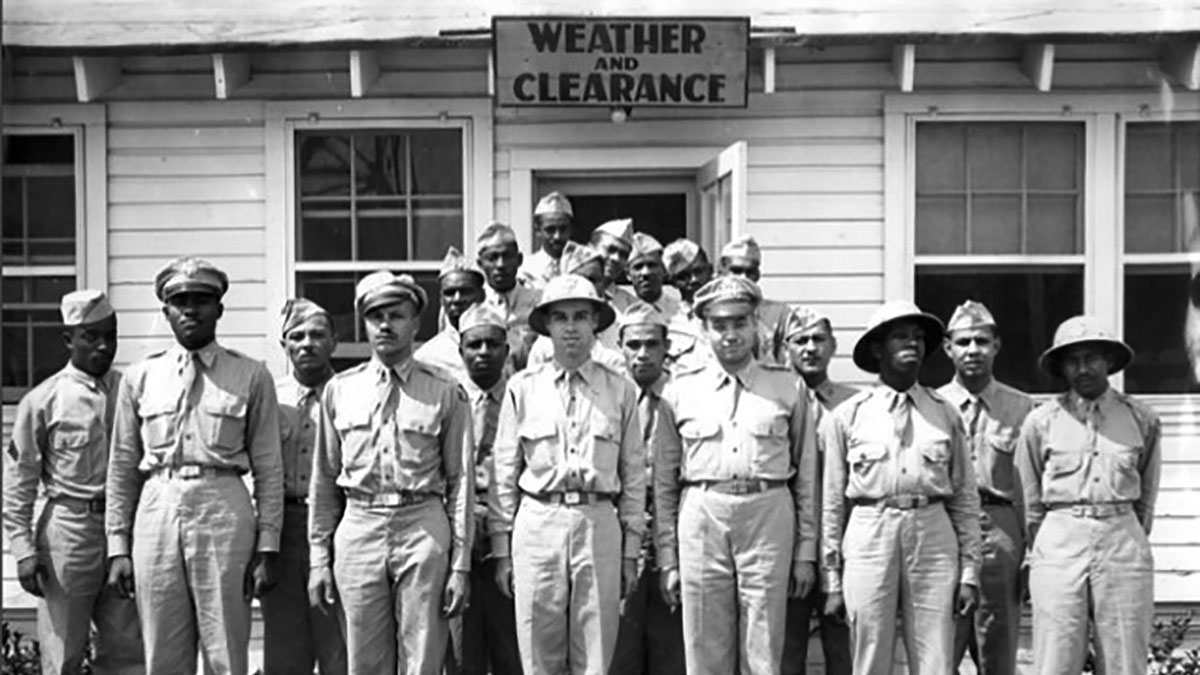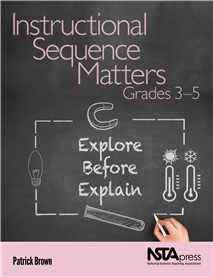NSTA Reports
Organizing for Student Success

Equity in STEM Education: It’s All About Culture!
By Alicia Santiago
Medical Schools Offer STEM Pipeline Programs
By Debra Shapiro

Idea Bank
Incorporating the Stories of Women, People of Color, and LGBTQ+ Scientists Into the Physics Classroom
The Game of Life and Death
Students discover how natural selection helps animals adapt to their environment.
NSTA Press
Explore Before Explain to Engage More Students
By Carole Hayward
Posted on 2020-02-23
A new addition to the Instructional Sequence Matters series has arrived! Instructional Sequence Matters, Grades 3-5 by Patrick Brown offers examples and strategies for using POE (Predict, Observe, and Explain) and 5E (Engage, Explore, Explain, Elaborate, and Evaluate) with students to tap into their innate curiosity and prepare them for deep learning.
Instructional Sequence Matters focuses on explore-before-explain teaching, which the author explains is a way of thinking “more purposefully and carefully about the nature of how we design instruction.”
Students come to the classroom as knowers already. They come with knowledge, ideas, experiences that have developed their understanding of how the world works. They come with a sense of curiosity, and questions, such as why do rainbows appear in the sky; why do leaves change colors; and why does the moon go through different phases, explains Brown. As they learn in school, they build on their previous experiences, correct errors in their thinking, revise misconceptions, and build new knowledge.
“I firmly believe that a significant task of science teaching is cultivating the innate skills that child scientists bring to school and balancing their ideas with purposeful pedagogical practices,” says Brown. “Bringing an explore-before-explain mindset to science teaching is a way to develop the budding scientist in each of your students.”
According to Brown, this instructional method has far-reaching implications in the elementary school classroom, beyond science instruction.
“[It] lends empirical support for the placement of other experiences in the elementary classroom to leverage the best possible learning experiences for students,” says Brown. “One of the hallmarks of explore-before-explain teaching is its emphasis on learning for understanding and wiring (or rewiring) the brain, so knowledge is deeply blanketed in evidence-based experiences.”
Brown’s objective is also to rewire how educators think about sequencing. Instructional Sequence Matters helps educators to understand the developmental psychology, neuroscience, cognitive science, and science education research that explains why the order in which lessons are structured is so critical.
The book provides examples that show how specific aspects of all three dimensions of the Next Generation Science Standards can translate into the classroom: 1) science and engineering practices, 2) disciplinary core ideas, and 3) crosscutting concepts. It includes detailed, ready-to-teach lessons that use either a POE or 5E sequence to cover a variety of science topics such as heat and temperature, magnetism, and electric currents.
Instructional Sequence Matters will help educators to promote long-lasting understanding by motivating their students, encouraging them to think critically, and engaging them more deeply with content.
Read the free chapter “Learning About Ecosystems.”
Go Green This Spring, Apply for a Green Ribbon School Award by Jim Elder
By Kate Falk
Posted on 2020-02-20
Is your school a green school?
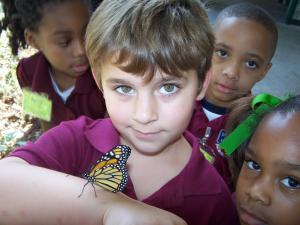 Is it doing amazing work in reducing environmental impacts, such as waste, water, energy, and transportation?
Is it doing amazing work in reducing environmental impacts, such as waste, water, energy, and transportation?
Does your school work to improve the health and wellness of students and faculty with coordinated school health programs that take into consideration air quality, contaminant control, acoustics, daylighting, thermal comfort, school food, and more?
Is your school a leader in effective environmental and sustainability education that emphasizes hands-on, real-world learning, civic engagement, STEM connections, and green career preparation?
Then you should apply for a Green Ribbon School Award sponsored by the U.S. Department of Education and administered by state education authorities.
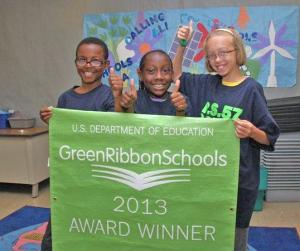 Only 50-80 schools in the country win each year, so it’s a big deal. it puts your school in an elite national group of green schools; winning schools get a good deal of national, state and local press; the award helps schools attract more funding as well as community support; and the award builds school spirit both within the school and in the community. Winning schools are invited to the award ceremony in Washington DC.
Only 50-80 schools in the country win each year, so it’s a big deal. it puts your school in an elite national group of green schools; winning schools get a good deal of national, state and local press; the award helps schools attract more funding as well as community support; and the award builds school spirit both within the school and in the community. Winning schools are invited to the award ceremony in Washington DC.
The premise of the Green Ribbon Schools is simple: It seeks to promote effective school sustainability and collaboration. Applicants are measured on how they perform on three key pillars:
- Reducing environmental impact and costs;
- Improving health and wellness; and
- Providing effective environmental and sustainability education.
Here are two examples of the great programs coming out of Green Ribbon Schools:
For over twelve years, Virginia Beach Public Schools has been moving towards a more sustainable model. To date, it has completed eight LEED buildings ranging from basic certification to Platinum. The Sustainable Schools Committee works with a Sustainable School Liaison in each school, and have been able to establish 64 schools with outdoor teaching gardens, 72 schools with environmental clubs, and over 60 schools that partner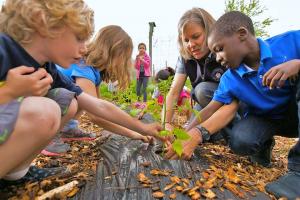 with third party environmental organizations like the Chesapeake Bay Foundation.
with third party environmental organizations like the Chesapeake Bay Foundation.
Environmental education extends far beyond the walls of a traditional science classroom at Quincy High School, a career and technical school. Summer Leadership Camp, which pairs upperclassmen with incoming 9th grade students, offers an outdoor learning experience that builds friendship and leadership skills. The school’s STEM wing is home to a greenhouse, where students are actively involved in learning how to grow their own food. Students complete “Service to School and Community” hours that allow them to focus on how singular responsible actions can benefit the larger environment and affect the sustainable practices of other members within the community.
Schools and districts do not apply for the award to the U.S. Department of Education, but to their state education authorities. (State participation in the award is voluntary so contacting your state official will help them to determine their level of participation.)
If you are interested in learning more, I encourage you to contact your state departments of education or the state authority on this list.
Jim Elder is Executive Director of the Campaign for Environmental Literacy.
The mission of NSTA is to promote excellence and innovation in science teaching and learning for all.
Is your school a green school?
 Is it doing amazing work in reducing environmental impacts, such as waste, water, energy, and transportation?
Is it doing amazing work in reducing environmental impacts, such as waste, water, energy, and transportation?
Does your school work to improve the health and wellness of students and faculty with coordinated school health programs that take into consideration air quality, contaminant control, acoustics, daylighting, thermal comfort, school food, and more?
Ask a Mentor
Multicultural Scientific Contributions Matter Every Day
By Sharon Delesbore
Posted on 2020-02-18
February is designated as Black History Month. Why is this the only time that black inventors and scientists are recognized?
—Tammy, Alabama
It is important to expose students to the many significant accomplishments that black scientists and inventors have contributed to the world. I don’t know of any performance expectations or state standards that specifically state, “Expose students to multicultural scientists and inventors within the curriculum of science education,” but cultural relevance has come to the forefront of engaging students to increase academic success. Students become more engaged in their learning when they recognize themselves in the concepts they’re studying. For example, a lesson in computer science class may become more interesting to students of color when they learn that a black female was one of the inventors behind animated GIF technology. Lisa Gelobter played an integral part in the creation of Shockwave Flash, which helped popularize web animation. Pique the interest of black male students with a discussion of Philip Emeagwali, who was inspired to rethink computer processing while studying bees. In 1989, he invented the world’s first supercomputer able to perform 3.1 billion calculations per second. Known as “the Black Bill Gates of Africa,” he ignited a revolution in technology. Check out “14 Black Inventors You Probably Didn’t Know About” on Thinkgrowth.org at http://bit.ly/2uxx23S for more. Educators should take the opportunity to incorporate multicultural acknowledgement in their curriculum, integrating them in lessons throughout the school year because Black History is American History.
February is designated as Black History Month. Why is this the only time that black inventors and scientists are recognized?
—Tammy, Alabama
Early Childhood / Preschool Blog
Using rain to manipulate art media, and modeling rain
By Peggy Ashbrook
Posted on 2020-02-15
A day where the rain had lasted so long that the playground became soupy led to an investigation of the properties of art media—tempera paint and oil pastels. As a science investigation we (most of us) followed my procedure of using tempera paint on one half of a page and oil pastels on the other half.

What the children designed with the media was their choice. As they worked I asked children to compare the two media—how well did the media stick to the paper, what kinds of lines could they make with either media, were the media wet or dry, and if they had a preference for hand-and-stick of pastel or paint-on-brush.
Most of the children, ages 3.5-5 years old, did not draw “anything,” perhaps because it wasn’t truly their creation, simply an investigation that I suggested with certain media. They applied the media in layers, adding colors until they decided they were finished. A few interests were revealed in the children’s work: math (shapes and patterns), spreading paint, mixing colors, the freedom to “scribble scrabble,” and rainbows, as well as stylistic differences.
In a separate activity I provided some plastic quart containers with holes in the bottom to model rain, or to just see what happens when we drop water over objects: plastic toys, sticks, and shells. Children had fun controlling the dripping flow of water (ESS2.C The roles of water in Earth’s surface processes). We had small towels at hand to absorb spills as children practiced pouring.
One child observed the displacement of water, something I had not planned on but a wonderful opportunity to discuss what she thought.
Another child observed that when most of the water had dripped out, a little water remained in the container and did not go through the holes. To extend this activity I could provide containers with even smaller holes which make the water come out in drops, set up some activities to closely view water flow and water tension, and give children materials that change when “rained” on, perhaps sand to make a landscape (ESS2.A Earth materials and systems). The links to the Next Generation Science Standards provide information on the Science and engineering practices, Disciplinary core ideas, and Crosscutting concepts–children’s understandings of them are built on these kinds of beginning explorations.
The next time we met, our conversations about what changes the rain made to their finished work with the two media were brief. “It got wet!” “Now it’s dry.” What I want to know is if they wondered why the pastel lines did not blur or spread out in the rain like the paint shapes did, and if they are aware of the waxy feel of the pastels (PS1.A Structure of matter ). What next steps could I introduce? Maybe I should wait for children to bring up their own experiences with rain. Perhaps we could get out the “rain” containers on a warm rainy day and compare the shape of natural rain drops splashes to those from the containers. Or on one of the scheduled summer playground “water days” have children paint directly on a large Plexiglas easel and spray it after painting. Oil pastels on the Plexiglas? The children would probably enjoy scrubbing it off with soapy water—another way to learn about the differences between media.
A day where the rain had lasted so long that the playground became soupy led to an investigation of the properties of art media—tempera paint and oil pastels. As a science investigation we (most of us) followed my procedure of using tempera paint on one half of a page and oil pastels on the other half.
Legislative Update
President Releases Education Budget for FY21 Programs
By Jodi Peterson
Posted on 2020-02-14
The Trump Administration released its education budget for FY2021 last week, and it was immediately and rounded criticized by education advocates and denounced by Democratic lawmakers.
The president is proposing a 7.8 percent cut to U.S. Department of Education programs. The $66.6 billion request represents a $5.6 billion reduction from the department’s enacted 2020 funding level and is part of the Administration’s plan to cut billions in non-defense spending.
Further, the budget seeks combine 29 K-12 grant programs into a $19.4 billion unified block grant, called the Elementary and Secondary Education for the Disadvantaged Block Grant. This represents a $4.7 billion cut from the enacted FY2020 funding levels for these combined programs. It would affect practically every program under the Every Student Succeeds Act, including ESSA Titles IVA, ESSA Title II, ESSA Title I, and the 21st Century Community Learning Centers.
The proposed Elementary and Secondary Education for the Disadvantaged Block Grant would be allocated through existing Title I grant formulas and could be used to support any activity supported by the consolidated programs.
Education Secretary Betsy DeVos said the new block grant would “end education earmarks” and transform how states use federal dollars in a way that aligns with the federal education law.
Education advocates were not happy with this budget. In a statement, American Federation of Teachers President Randi Weingarten said the block grant proposal was “simply code for less funding to the schools and communities that need it most.”
The Title IVA Coalition (NSTA is a member) released this statement shortly after the budget was released: “While we are not surprised by the President’s failure to provide adequate funding for public education programs under the Every Student Succeeds Act, we are deeply concerned that the FY21 budget proposal would violate congressional intent. The proposal aims to consolidate 29 discretionary education programs and combine them into a singular block grant while failing to provide equal to or more funding for the existing programs, resulting in a net cut. Specifically, we are dismayed that this Administration would cut Title IV-A of ESSA, the strongly bipartisan flexible block grant that provides funding for safe and healthy students, well-rounded programs, and the effective use of educational technology. Sadly, this budget is yet another demonstration of the Administration’s complete lack of commitment to the success of the public education system and lack of respect for Congressional intent.”
The administration’s budget also includes plans for Education Freedom Scholarships that would create a $5 billion federal tax credit for donations to scholarship-granting organizations to pay for students to attend private schools or expand their public education options. Legislation to authorize these scholarships has been introduced in the House as H.R. 1434 (116) and the Senate as S. 634 (116).
The budget also proposes a $900 million increase for career and technical education programs. In a fact sheet, the White House Office of Management and Budget states this increase “would help ensure that all American high schools offer high-quality vocational training programs and that all students have access to pathways other than costly 4 year degrees to well-paying jobs.”
The President budget is seeking $931 million for the National Science Foundation Education and Human Resources Directorate, and is calling for eliminating funding for NASA’s Office of STEM Engagement.
In previous years, Congress has largely rejected the attempts by the Administration to cut funding for specific education programs. NSTA will be working with other advocates throughout the year urging Congress to increase funding for vital education programs such as Title IVA, Title II, and Title I.
The budget tracker developed by our friends at the STEM Education Coalition is below.
| Program | FY2019 Omnibus | POTUS FY2020 Request | FY2020 Minubus | POTUS FY2021 Request |
| ESSA Title I-A Grants to Local Education Agencies | $15.86B | $15.86B | $16.30B | $0 (consol.) |
| ESSA Title II SupportingEffective Instruction Grants | $2.05B | $0 | $2.13B | $0 (consol.) |
| Title IVA Student Support and Academic Enrichment Grants | $1.17B | $0 | $1.21B | $0 (consol.) |
| Title IVB 21st Century Community Learning Centers | $1.22B | $0 | $1.25B | $0 (consol.) |
| ESEA Formula and Competitive Block Grant1 | n/a | n/a | n/a | $19.36B |
| National Science Foundation’s Education and Human Resources Directorate | $916M | $823M | $940M | $931M |
| NASA STEM Engagement | $110M | $0 | $120M | $0 |
| Career and Technical Education State Grants | $1.26B | $1.26B | $1.28B | $1.96B |
| Education Innovation and Research Program | $130M | $300M | $130M | $0 (consol.) |
__________
1In their FY2021 request, the administration proposed to “consolidate nearly all currently funded formula and competitive grant programs authorized by ESSA into a single state formula grant program.”
Stay tuned, and watch for more updates in future issues of NSTA Express.
Jodi Peterson is the Assistant Executive Director of Communication, Legislative & Public Affairs for the National Science Teachers Association (NSTA) and Chair of the STEM Education Coalition. Reach her via e-mail at jpeterson@nsta.org or via Twitter at @stemedadvocate.
The mission of NSTA is to promote excellence and innovation in science teaching and learning for all.
The Trump Administration released its education budget for FY2021 last week, and it was immediately and rounded criticized by education advocates and denounced by Democratic lawmakers.
The president is proposing a 7.8 percent cut to U.S. Department of Education programs. The $66.6 billion request represents a $5.6 billion reduction from the department’s enacted 2020 funding level and is part of the Administration’s plan to cut billions in non-defense spending.



